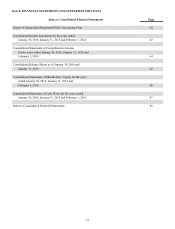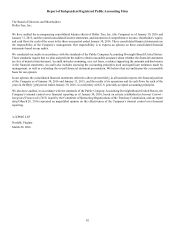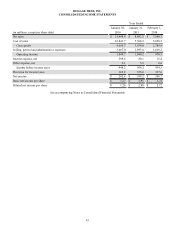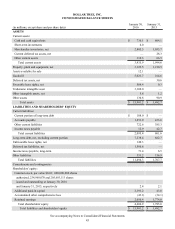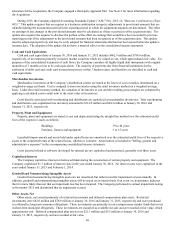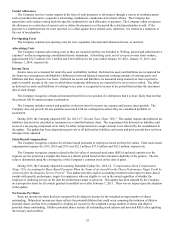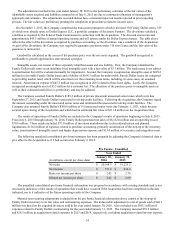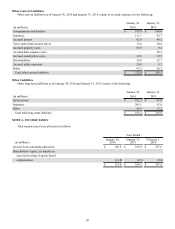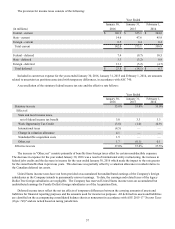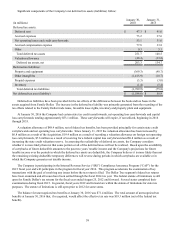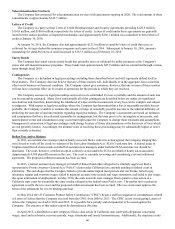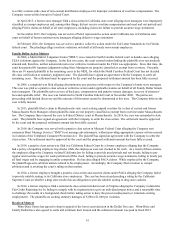Dollar Tree 2015 Annual Report Download - page 67
Download and view the complete annual report
Please find page 67 of the 2015 Dollar Tree annual report below. You can navigate through the pages in the report by either clicking on the pages listed below, or by using the keyword search tool below to find specific information within the annual report.
51
The following table sets forth the Company's financial assets and liabilities that are accounted for at fair value on a
recurring basis:
(in millions) January 30,
2016 January 31,
2015
Level 1
Restricted investments $ 82.0 $ 78.9
Short-term investments 4.0 —
Long-term debt - secured senior notes and acquisition notes 3,754.6 —
Level 2
Diesel fuel swap liabilities 0.8 5.7
Long-term debt - term loans 3,886.1 —
Level 3
Long-term debt - senior notes — 700.9
The Company’s cash and cash equivalents are valued at cost, which approximates fair value, due to the short-term
maturities of these instruments.
The fair values of the diesel fuel swaps were estimated using discounted cash flow calculations based upon forward
interest-rate yield and diesel cost curves. The curves were obtained from independent pricing services reflecting broker market
quotes.
The fair value of the Company's secured senior notes and acquisition notes at January 30, 2016 was determined using
Level 1 inputs as quoted prices in active markets for identical assets or liabilities are available. The fair value of the Company's
term loans at January 30, 2016 was determined using Level 2 inputs as quoted prices are readily available from pricing
services, but the prices are not published. The fair value of the Company's senior notes at January 31, 2015 was determined
through the use of a discounted cash flow analysis using Level 3 inputs as there were no quoted prices in active markets for this
debt. The discount rate used in the analysis was based on borrowing rates available to the Company for debt of the same
remaining maturities, issued in the same private placement debt market. The carrying value of the Company's Revolving
Credit Agreement at January 30, 2016 and the Company's Unsecured Credit Agreement at January 31, 2015, approximated their
fair values because the interest rates vary with market interest rates.
Certain assets and liabilities are measured at fair value on a nonrecurring basis; that is, the assets and liabilities are not
measured at fair value on an ongoing basis but are subject to fair value adjustments in certain circumstances (e.g., when there is
evidence of impairment). The Company recorded impairment charges of $1.6 million, $1.5 million, and $0.5 million in fiscal
2015, 2014 and 2013, respectively, to reduce certain store assets to their estimated fair values. The fair values were determined
based on the income approach, in which the Company utilized internal cash flow projections over the life of the underlying
lease agreements discounted based on a risk-free rate of return. These measures of fair value, and related inputs, are considered
a Level 3 approach under the fair value hierarchy. There were no other changes related to Level 3 assets.
Lease Accounting
The Company generally leases its retail locations under operating leases. The Company recognizes minimum rent expense
beginning when possession of the property is taken from the landlord, which normally includes a construction period prior to
store opening. When a lease contains a predetermined fixed escalation of the minimum rent, the Company recognizes the
related rent expense on a straight-line basis and records the difference between the recognized rental expense and the amounts
payable under the lease as deferred rent. The Company also receives tenant allowances, which are recorded in deferred rent
and are amortized as reductions of rent expense over the terms of the leases.
Revenue Recognition
The Company recognizes sales revenue at the time a sale is made to its customer.
Taxes Collected
The Company reports taxes assessed by a governmental authority that are directly imposed on revenue-producing
transactions (i.e., sales tax) on a net (excluded from revenue) basis.
Cost of Sales
The Company includes the cost of merchandise, warehousing and distribution costs, and certain occupancy costs in cost of
sales.


